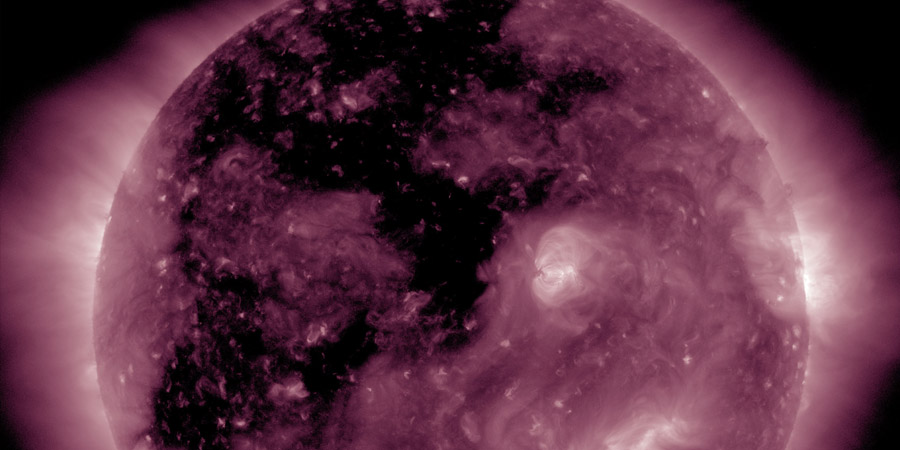She's back! Large coronal hole faces Earth again
Sunday, 23 October 2016 13:18 UTC

It is fairly clear we are well on our way to solar minimum but October has thus far been an interesting month despite the lack of any significant solar activity.
We started the month with waning coronal hole influences but the most exciting activity came from a coronal mass ejection that arrived on 12 October. This was a sneaky coronal mass ejection that was very hard to pinpoint to a specific solar event but thanks to STEREO Ahead we knew that it was launched from the earth-facing side of the Sun. While the coronal mass ejection looked faint on the SOHO/LASCO coronagraph imagery and was not very fast, the cloud did carry a strong magnetic field with it and it pushed the north-south direction of the IMF (Bz) southward even dipping below -20nT and that caused a significant geomagnetic response. On two consecutive days (13 October and 14 October) we reached moderate G2 geomagnetic storm conditions and aurorae we're seen from many locations around the world.
#Aurora early this morning Oct13/16 Central Alberta! #wx #TeamTanner @treetanner @TamithaSkov @weathernetwork @_SpaceWeather_ pic.twitter.com/EwNiQaVP9s
— Darlene Tanner (@dartanner) 13 oktober 2016
#Aurora 10/13 at 8:20pm CST @TamithaSkov @TweetAurora @NorthLightAlert @Aurora_Alerts @_SpaceWeather_ @StormHour pic.twitter.com/z6WCJvHWnY
— Corinne (@AuroraNorthWI) 14 oktober 2016
But that's the past. We are now focusing our attention on a solar feature that's been around for a long time and which many of you will remember. Indeed, its the large northern hemisphere polar coronal hole which stretches down all the way to the Sun's southern hemisphere! She's back allright! Or should we say he? Oh well, you decide. Our automated coronal hole detection system detected the coronal hole flawlessly and was quick to send out an alert on our Twitter channel... which you of course need to follow if you haven't done so already!
A coronal hole is facing Earth. Enhanced solar wind could arrive in ~3 days - Follow live on https://t.co/T1Jkf6i4Cb pic.twitter.com/qucdDilZgy
— SpaceWeatherLive (@_SpaceWeather_) 22 oktober 2016
If we use our archive to see how the coronal hole looks like compared to the last time it faced Earth, we can conclude that it definitely did not shrink and do we dare to say, it might have even grown in size at some places. The equatorial trailing part especially looks like it has increased.
The NOAA SWPC has a moderate G2 (Kp6) geomagnetic storm watch in effect for both Monday and Tuesday, which is something we can fully agree on but even on wednesday and beyond we should still feel the effects of this massive coronal hole. This coronal hole remains one of the largest coronal holes in recent history and there is no reason to believe we shouldn't be able to reach moderate storming conditions again during this rotation. Charge those batteries and dont forget to bring coffee, you aren't going to get much sleep this coming week.
Thank you for reading this article! Did you have any trouble with the technical terms used in this article? Our help section is the place to be where you can find in-depth articles, a FAQ and a list with common abbreviations. Still puzzled? Just post on our forum where we will help you the best we can!
Latest news
Latest forum messages
Support SpaceWeatherLive.com!
A lot of people come to SpaceWeatherLive to follow the Sun's activity or if there is aurora to be seen, but with more traffic comes higher server costs. Consider a donation if you enjoy SpaceWeatherLive so we can keep the website online!

Space weather facts
| Last X-flare | 2024/03/28 | X1.1 |
| Last M-flare | 2024/04/18 | M1.2 |
| Last geomagnetic storm | 2024/04/16 | Kp5 (G1) |
| Spotless days | |
|---|---|
| Last spotless day | 2022/06/08 |
| Monthly mean Sunspot Number | |
|---|---|
| March 2024 | 104.9 -19.8 |


